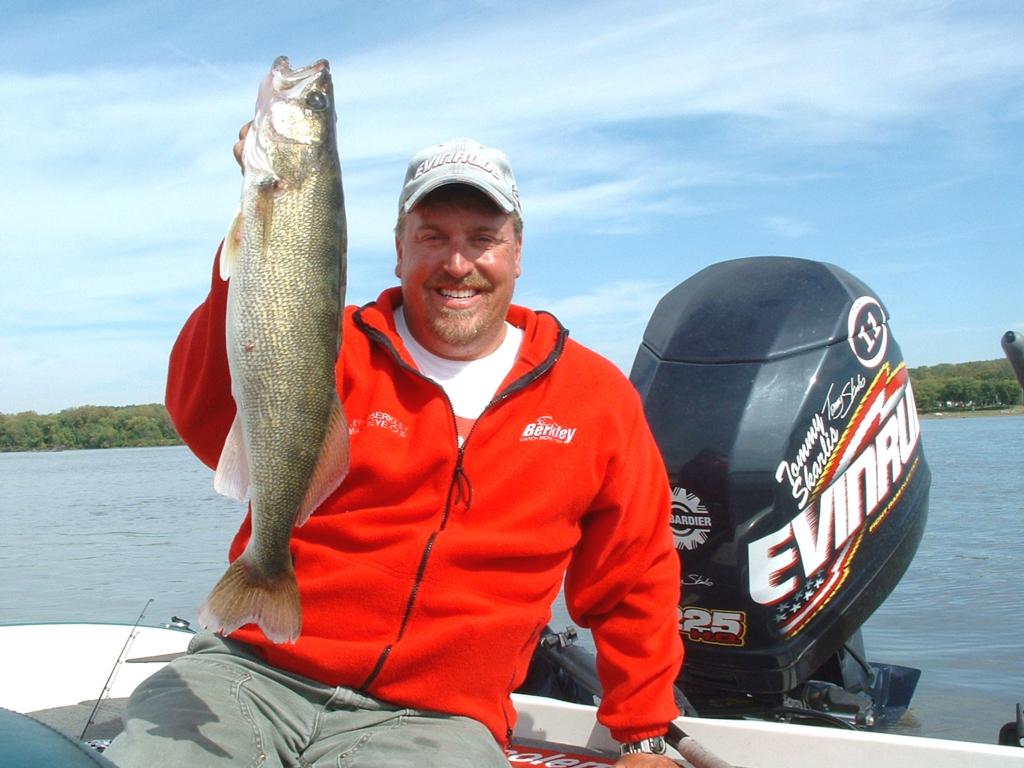Roll black water
Mississippi up but not impossible for RCL Championship

MOLINE, Ill. – All things considered, conditions on the Mississippi River could be better and could be worse for the Wal-Mart RCL Walleye Championship starting Wednesday and the run-up to a tournament win worth a potential $400,000 cash and an overall purse totaling $1.4 million.
The site of walleye angling’s most lucrative tournament is a series of the big river’s pools between Iowa and Illinois, where the numbers of walleyes are at their highest levels ever because of improved water quality and, in one stretch, a stocking program that has boosted the populations by at least one-third. When the field of 220 pros and as many co-anglers launches Wednesday from Pool 16, they are expected to take not only to 16 but also to the upriver pools of 14 and 15 and the downriver pool of 17.
Even though the RCL imposes no boundaries, the nearest neighboring pools in all likelihood will become the practical limits of fishable water given the time required both to travel and to lock through. With an eight-hour tournament day, half of it could be consumed by the four-hour roundtrip to and from (locking twice) Pool 14, a 29-mile-long, 10,000-acre stretch that is home to the river’s best walleye populations in the region. The reason: stocking of 150,000 walleye fingerlings annually in return for the use of pool water by a nuclear plant on its banks.
Feeling Minnesota
But despite the decent numbers on 14 and elsewhere, the fish are in something of a funk (anglers, too) because of heavy rains that fell within the last couple of weeks in Minnesota, a slug of water that is now arriving in the Quad Cities of Moline and Rock Island, Ill., and Davenport and Bettendorf, Iowa.
“It’s all running through,” says Evinrude pro Tommy Skarlis of Walker, Minn., a river rat benefiting from formative years living in Iowa and fishing on the Mississippi. “I wouldn’t call the river high. I’d say it looks good after all these dry years.
“The harsh reality is that it’s dirtier than normal, and it’s got a ton of gunk in it from all the sloughs flushing out with the high water. It fouls your presentation, and the fish aren’t going to eat your lure when it has a hula skirt on it.”
Another confounding factor contributing to tepid results during pre-tournament practice is the warm water temperatures in the low-70-degree range just ahead of October 1 – with recent days in the 80s, a full 10 degrees warmer than water temperature that would otherwise encourage the fish to feed.
“The big disadvantage is we’re right at the tail end of the summer doldrums,” says Skarlis, who hears tell of 40-fish days having occurred in the last couple of months. “The fishing has been fantastic all summer, but the fish are going to be lackadaisical until they put on the feed bag in late October.”
However the fish ultimately bite, there’s no shortage of options to catch them, just limitations as far as the ones that can be kept and weighed.
On this series of pools, a definite possibility is a pattern of jigging wing dams, the underwater rock jetties used by the Army Corps of Engineers to divert current to the main channel. There are thousands of them in the area, and all are not created equal. Some are shallower, some deeper, and a select few might hold the proper fish to contend for the competitive top-12 cut after day two.
“In the fishable stretches of water, you’re looking at 2,000 wing dams, of which 20 might be the right ones,” says Ranger pro Carl Grunwaldt of Green Bay, Wis., the winner of 2004’s qualifying tournament on Lake Erie.
Aware of the fallout from earlier rainfall, Grunwaldt says he has been discouraged by the trolling – say, trolling crankbaits on leadcore line – which would normally contend as a top pattern. In time, it still may.
“The high water came, the clarity went down, and the volume came way up,” Grunwaldt says. “There’s so much debris, it’s extremely difficult to get a trolling bite. Come tournament time, that could be all flushed out.”
Then again, the worst-case scenario could have been a river at flood stage, a scene from the first qualifying tournament of the year on the Illinois River. Well short of flooding, with no deluges in the foreseeable future, the good news it that conditions on the volatile Mississippi could be far worse.
Keeper conundrum
The catch, though, is that the competitors quite likely won’t be able to keep all they catch. Plenty of undersized fish, below the state minimum of 15 inches, are present. Furthermore, in place is a slot limit that requires immediate release of all walleyes between 20 inches and 27 inches.
The reason for the slot is to protect susceptible females, the best spawners, during wintertime tail-fisheries, according to John Pitlow, a biologist with the Iowa Department of Natural Resources. No slot exists for saugers.
“Those sauger could come into play due to the fact there’s no slot limit on them,” Grunwaldt says. “Twenty-two-inch sauger are pretty healthy – they’re almost the same size as the walleye.”
For the championship, the bag limit is five fish per team – not an easy task to amass considering the current affairs. That said, a select crew is bound to get the job done.
The 220 RCL Walleye Championship teams will start fishing – or running and locking, whichever the case may be – at 7 a.m. Wednesday from Sunset Park in Rock Island.